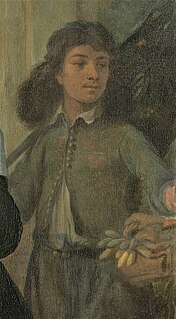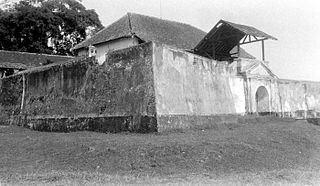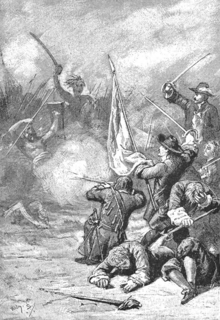Related Research Articles

Java is one of the Greater Sunda Islands in Indonesia. It is bordered by the Indian Ocean to the south and the Java Sea to the north. With a population of 147.7 million people, Java is the world's most populous island, constituting approximately 55% of the Indonesian population.

Batavia, also called Batauia in the city's Malay vernacular, was the capital of the Dutch East Indies. The area corresponds to present-day Jakarta, Indonesia. Batavia can refer to the city proper or its suburbs and hinterland, the Ommelanden, which included the much-larger area of the Residency of Batavia in the present-day Indonesian provinces of Jakarta, Banten and West Java.

The Invasion of Java in 1811 was a successful British amphibious operation against the Dutch East Indian island of Java that took place between August and September 1811 during the Napoleonic Wars. Originally established as a colony of the Dutch Republic, Java remained in Dutch hands throughout the French Revolutionary and Napoleonic Wars, during which time the French invaded the Republic and established the Batavian Republic in 1795, and the Kingdom of Holland in 1806. The Kingdom of Holland was annexed to the First French Empire in 1810, and Java became a titular French colony, though it continued to be administered and defended primarily by Dutch personnel.

The Sultanate of Mataram was the last major independent Javanese kingdom on the island of Java before it was colonised by the Dutch. It was the dominant political force radiating from the interior of Central Java from the late 16th century until the beginning of the 18th century.

The Java War or Diponegoro War (ꦥꦼꦫꦁꦢꦶꦥꦤꦼꦒꦫ) was fought in central Java from 1825 – 1830, between the colonial Dutch Empire and native Javanese rebels. The war started as a rebellion led by Prince Diponegoro, a leading member of the Javanese aristocracy who had previously cooperated with the Dutch.

Hamengkubuwono I, born Raden Mas Sujana, was the first sultan of Yogyakarta, reigning between 1755 and 1792.

Yogyakarta is the capital city of Special Region of Yogyakarta in Indonesia, on the island of Java. As the only Indonesian royal city still ruled by a monarchy, Yogyakarta is regarded as an important centre for classical Javanese fine arts and culture such as ballet, batik textiles, drama, literature, music, poetry, silversmithing, visual arts, and wayang puppetry. Renowned as a centre of Indonesian education, Yogyakarta is home to a large student population and dozens of schools and universities, including Gadjah Mada University, the country's largest institute of higher education and one of its most prestigious.

Adriaan Valckenier was Governor-General of the Dutch East Indies from 1737 to 1741. Mainly remembered for his involvement in the 1740 Batavia massacre, Valckenier later died in a prison in Batavia.

The 1740 Batavia massacre was a massacre in which Javanese people and soldiers of the VOC soldiers and native killed ethnic Chinese residents of the port city of Batavia in the Dutch East Indies. The violence in the city lasted from 9 October 1740 until 22 October, with minor skirmishes outside the walls continuing late into November that year. Historians have estimated that at least 10,000 ethnic Chinese were massacred; just 600 to 3,000 are believed to have survived.

Surakarta Sunanate was a Javanese monarchy centred in the city of Surakarta, in the province of Central Java, Indonesia.
Discrimination against people of Chinese descent in Indonesia has been carried out by governments in Indonesia since the time of the Dutch East India Company. Serious violence against Chinese people has occurred at irregular intervals since 1740, when the soldiers of the Dutch East India Company and other ethnic groups from Batavia killed up to 10,000 people of Chinese descent during the Chinezenmoord. The worst outbreaks took place in 1946-49 during the Indonesian National Revolution against Dutch rule. There were significant outbreaks in the early 1960s. Violence against Chinese also took place in 1965 after the failed coup attempt during anti-communist purges, the main target of the killings were Native Indonesian communists. In May of 1998, many Chinese businesses were burned down and many Chinese girls and women were brutally raped and murdered.
The Java War of 1741 to 1743 was an armed struggle by a joint Chinese and Javanese army against the Dutch colonial government and pro-Dutch Javanese that took place in central and eastern Java. Ending in victory for the Dutch, the war led to the fall of the Sultanate of Mataram and, indirectly, the founding of both the Sunanate of Surakarta and the Sultanate of Yogyakarta.

Untung Suropati was an Indonesia war fighter who led a few rebellions against the Dutch East India Company (VOC).

French and British interregnum in the Dutch East Indies were a relatively short period of French and followed by British interregnum on the Dutch East Indies that took place between 1806 and 1816. The French ruled between 1806 and 1811. The British took over for 1811 to 1816, and transferred its control back to the Dutch in 1816.

Fort Willem II of Ungaran is a late 18th-century Dutch-built fort located in Ungaran, in the Semarang Regency, Central Java, Indonesia. It was constructed to guard a trade route in central Java. The fort is the place where Prince Diponegoro was imprisoned while waiting for his judgment in Batavia and further exile to Makassar. The fort is currently used as a dormitory for the families of Indonesian police personnel.

Trunajaya rebellion or Trunajaya War was the ultimately unsuccessful rebellion waged by the Madurese prince Trunajaya and fighters from Makassar against the Mataram Sultanate and its Dutch East India Company (VOC) supporters in Java during the 1670s.
The Battle of Gegodog took place in 13 October 1676 during the Trunajaya rebellion, and resulted in the victory of the rebel forces over the Mataram army led by the Crown Prince Pangeran Adipati Anom. Gegodog is located in the northeastern coast of Java, east of Tuban.
Khe Pandjang, also known as Khe Sepanjang, Que Pandjang, Si Pandjang, or Sie Pan Djiang was an 18th-century Indonesian military leader. Pandjang fought against Dutch forces during the Java War (1741–1743).

Indonesian numismatic charms, also known as Indonesian magic coins, are a family of coin-like objects based on a similar Chinese family of coin charms, amulets, and talismans but evolved independently from them. Indonesian numismatic charms tend to have been influenced a lot by Hinduism, Islam, and the native culture and often depict religious imagery from Hinduism for this reason. The "magic coins" and temple coins from Indonesia are largely based on the Chinese cash coins introduced to the region during the Tang dynasty era in China, and during the local Majapahit era they began circulating in the region. Unlike with Chinese numismatic charms, the coin charms of Indonesia have not been as well documented both historically and in the modern era. A major modern day work about Indonesian numismatic charms in English is Joe Cribb's Magic coins of Java, Bali, and the Malay Peninsula which is a catalogue based on the collection of coin-shaped charms from the island Java acquired by Sir Thomas Stamford Raffles during his lifetime held in the British Museum, the book is further supplemented with data and information available from various other sources.
A Kong Koan or 'Chinese Council', was a high government body in the major capitals of the Dutch East Indies, consisting of all incumbent Chinese officers in those cities. It acted as both a judicial and executive authority and constituted part of the Dutch colonial system of 'indirect rule'.
References
- 1 2 3 4 Raffles, Thomas Stamford (1830) [1817]. The History of Java . 2. London: Black. OCLC 312809187. pp. 235, 236, 242-244
- 1 2 3 4 5 6 7 8 9 Setiono, Benny G. (2008). Tionghoa dalam Pusaran Politik [Indonesia's Chinese Community under Political Turmoil] (in Indonesian). Jakarta: TransMedia Pustaka. ISBN 979-799-052-4. pp. 111, 114–116, 119, 147–152, 157
- ↑ Ricklefs, Merle Calvin (1983). "The crisis of 1740–1 in Java: the Javanese, Chinese, Madurese and Dutch, and the Fall of the Court of Kartasura". Bijdragen tot de Taal-, Land- en Volkenkunde. 139 (2/3): 268–290
- ↑ Raffles, Thomas Stamford (1817). The History of Java. Black, Parbury & Allen.